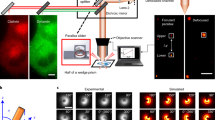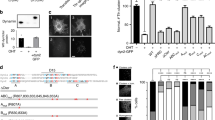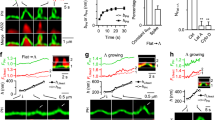Abstract
The GTPase dynamin plays an essential part in endocytosis by catalysing the fission of nascent clathrin-coated vesicles from the plasma membrane. Using preformed phosphatidylinositol-4,5-bisphosphate-containing lipid nanotubes as a membrane template for dynamin self-assembly, we investigate the conformational changes that arise during GTP hydrolysis by dynamin. Electron microscopy reveals that, in the GTP-bound state, dynamin rings appear to be tightly packed together. After GTP hydrolysis, the spacing between rings increases nearly twofold. When bound to the nanotubes, dynamin"s GTPase activity is cooperative and is increased by three orders of magnitude compared with the activity of unbound dynamin. An increase in the kcat (but not the Km) of GTP hydrolysis accounts for the pronounced cooperativity. These data indicate that a novel, lengthwise (‘spring-like’) conformational change in a dynamin helix may participate in vesicle fission.
This is a preview of subscription content, access via your institution
Access options
Subscribe to this journal
Receive 12 print issues and online access
$209.00 per year
only $17.42 per issue
Buy this article
- Purchase on Springer Link
- Instant access to full article PDF
Prices may be subject to local taxes which are calculated during checkout






Similar content being viewed by others
References
Roos, J. & Kelly, R. B. Is dynamin really a ‘pinchase’? Trends Cell Biol. 7, 257– 259 (1997).
McNiven, M. A. Dynamin: a molecular motor with pinchase action. Cell 94, 151–154 (1998).
Schmid, S. L. Clathrin-coated vesicle formation and protein sorting: an integrated process . Annu. Rev. Biochem. 66, 511– 548 (1997).
DeCamilli, P. & Takei, K. Molecular mechanisms in synaptic vesicle endocytosis and recycling. Neuron 16, 481 –486 (1996).
Poodry, C. A. & Edgar, L. Reversible alterations in the neuromuscular junctions of Drosophila melanogaster bearing a temperature-sensitive mutation, shibire. J. Cell Biol. 81, 520–527 (1979).
Koenig, J. H. & Ikeda, K. Disappearance and reformation of synaptic vesicle membrane upon transmitter release observed under reversible blockage of membrane retrieval. J. Neurosci. 9, 3844 –3860 (1989).
Ramaswami, M., Krishnan, K. S. & Kelly, R. B. Intermediates in synaptic vesicle recycling revealed by optical imaging of Drosophila neuromuscular junctions. Neuron 13, 363–375 ( 1994).
Takei, K., McPherson, P. S., Schmid, S. L. & DeCamilli, P. Tubular membrane invaginations coated by dynamin rings are induced by GTPγS in nerve terminals. Nature 374, 186– 190 (1995).
Herskovits, J. S., Burgess, C. C., Obar, R. A. & Vallee, R. B. Effects of mutant rat dynamin on endocytosis. J. Cell Biol. 122, 565–578 (1993).
van der Bliek, A. M. et al. Mutations in human dynamin block an intermediate stage in coated vesicle formation. J. Cell Biol. 122, 553–563 (1993).
Wigge, P. & McMahon, H. T. The amphiphysin family of proteins and their role in endocytosis at the synapse. Trends Neurosci. 21, 339–344 ( 1998).
Shupliakov, O. et al. Synaptic vesicle endocytosis impaired by disruption of dynamin-SH3 domain interactions. Science 276, 259– 263 (1997).
Marks, B. & McMahon, H. T. Calcium triggers calcineurin-dependent synaptic vesicle recycling in mammalian nerve terminals. Curr. Biol. 8, 740–749 ( 1998).
Slepnev, V. I., Ochoa, G. C., Butler, M. H., Grabs, D. & DeCamilli, P. Role of phosphorylation in regulation of the assembly of endocytic coat complexes. Science 281, 821–824 (1998).
Owen, D. J. et al. Crystal structure of the Amphiphysin-2 SH3 domain and its role in prevention of dynamin ring formation. EMBO J. 17, 5273–5285 (1998).
Vallis, Y., Wigge, P., Marks, B., Evans, P. R. & McMahon, H. T. Importance of the pleckstrin homology domain of dynamin in clathrin-mediated endocytosis. Curr. Biol. 9, 257–260 (1999).
Achiriloaie, M., Barylko, B. & Albanesi, J. P. Essential role of the dynamin pleckstrin homology domain in receptor mediated endocytosis. Mol. Cell. Biol. 19, 1410–1415 (1999).
Zheng, J. et al. Identification of the binding site for acidic phospholipids on the pH domain of dynamin: implications for stimulation of GTPase activity . J. Mol. Biol. 255, 14– 21 (1996).
Salim, K. et al. Distinct specificity in the recognition of phosphoinositides by the pleckstrin homology domains of dynamin and Bruton"s tyrosine kinase . EMBO J. 15, 6241–6250 (1996).
Klein, D. E., Lee, A., Frank, D. W., Marks, M. S. & Lemmon, M. A. The pleckstrin homology domains of dynamin isoforms require oligomerization for high affinity phosphoinositide binding. J. Biol. Chem. 273, 27725–27733 (1998).
Barylko, B. et al. Synergistic activation of dynamin GTPase by Grb2 and phosphoinositides . J. Biol. Chem. 273, 3791– 3797 (1998).
McPherson, P.S. et al. A presynaptic inositol-5-phosphatase. Nature 379, 353–357 (1996).
Takei, K. et al. Generation of coated intermediates of clathrin-mediated endocytosis on protein-free liposomes. Cell 94, 131– 141 (1998).
Sweitzer, S. M. & Hinshaw, J. E. Dynamin undergoes a GTP-dependent conformational change causing vesiculation. Cell 93, 1021–1029 ( 1998).
Koenig, J. H. & Ikeda, K. Synaptic vesicles have two distinct recycling pathways. J. Cell Biol. 135, 797 –808 (1996).
Deutsch, J. W. & Kelly, R. B. Lipids of synaptic vesicles: relevance to the mechanism of membrane fusion. Biochemistry 20, 378–385 ( 1981).
Tuma, P. L., Stachniak, M. C. & Collins, C. A. Activation of dynamin GTPase by acidic phospholipids and endogenous rat brain vesicles. J. Biol. Chem. 268 , 17240–17246 (1993).
Steinweis, P. C. & Gilman, A. G. Aluminium: a requirement for activation of the regulatory component of adenylate cyclase by fluoride. Proc. Natl Acad. Sci. USA 79, 4888–4891 (1982).
Carr, J. F. & Hinshaw, J. E. Dynamin assembles into spirals under physiological salt conditions upon the addition of GDP and gamma-phosphate analogues. J. Biol. Chem. 272, 28030– 28035 (1997).
Shpetner, H. S. & Vallee, R. B. Dynamin is a GTPase stimulated to high levels of activity by microtubules. Nature 355, 733–735 ( 1992).
Gout, I. et al. The GTPase dynamin binds to and is activated by a subset of SH3 domains. Cell 75, 25–36 (1993).
Herskovits, J. S., Shpetner, H. S., Burgess, C. C. & Vallee, R. B. Microtubules and src homology 3 domains stimulate the dynamin GTPase via its C-terminal domain. Proc. Natl Acad. Sci. USA 90, 11468–11472 (1993).
Robinson, P. J. et al. Dynamin GTPase regulated by protein kinase C phosphorylation in nerve terminals. Nature 365, 107– 108 (1993).
Tuma, P. L. & Collins, C. A. Activation of dynamin GTPase is a result of positive cooperativity. J. Biol. Chem. 269, 30842–30847 (1994).
Warnock, D. E., Hinshaw, J. E. & Schmid, S. L. Dynamin self-assembly stimulates its GTPase activity . J. Biol. Chem. 271, 22310– 22314 (1996).
Shpetner, H. S. & Vallee, R. B. Identification of dynamin, a novel mechanochemical enzyme that mediates interactions among microtubules. Cell 59, 421– 432 (1989).
Otero, A. D. Transphosphorylation and G protein activation. Biochem. Pharmacol. 39, 1399–1404 ( 1990).
Monod, J., Wyman, J. & Changeux, J.-P. On the nature of allosteric transitions: a plausible model. J. Mol. Biol. 12, 88– 118 (1965).
Smith, C. J., Grigorieff, N. & Pearse, B. M. Clathrin coats at 21 Å resolution: a cellular assembly designed to recycle multiple membrane receptors. EMBO J. 17, 4943–4953 ( 1998).
Heuser, J. E. The role of coated vesicles in recycling of synaptic vesicle membrane. Cell Biol. Int. Report 13, 1063–1076 (1989).
Needham, D. & Nunn, R. S. Elastic deformation and failure of lipid bilayer membranes containing cholesterol. Biophys. J. 58, 997–1009 ( 1990).
Block, S. M. Nanometers and piconewtons — the macromolecular mechanics of kinesin . Trends Cell Biol. 5, 169 ( 1995).
Takei, K., Slepnev, V. I., Hauck, V. & De Camilli, P. Amphiphysin tubulates protein free liposomes and regulates the formation of clathrin- and dynamin- coated structures in vitro. Mol. Biol. Cell Abstr. 9-S, 130 (1998).
Polyakov, A., Severinova, E. & Darst, S. A. Three dimensional structure of E. coli core RNA polymerase: promoter binding and elongation conformations of the enzyme. Cell 83, 365–373 ( 1995).
Warnock, D. E. & Schmid, S. L. Dynamin GTPase, a force-generating molecular switch. Bioessays 18, 885–894 (1996).
Goldstein, A. S., Lukyanov, A. N., Carlson, P. A., Yager, P. & Gelb, M. H. Formation of high-axial-ratio-microstructures from natural and synthetic sphingolipids. Chem. Phys. Lipids 88, 21–36 (1997).
Wigge, P. et al. Amphiphysin heterodimers: potential role in clathrin-mediated endocytosis. Mol. Biol. Cell 8, 2003– 2015 (1997).
Acknowledgements
We thank M. M. Kozlov for discussions and providing unpublished data, and N. Unwin for encouragement and discussions. This work was supported by the MRC and an NSF-NATO Postdoctoral Fellowship (M.H.B.S.).
Correspondence and requests for materials should be addressed to H.T.M.
Author information
Authors and Affiliations
Corresponding author
Rights and permissions
About this article
Cite this article
Stowell, M., Marks, B., Wigge, P. et al. Nucleotide-dependent conformational changes in dynamin: evidence for a mechanochemical molecular spring. Nat Cell Biol 1, 27–32 (1999). https://doi.org/10.1038/8997
Received:
Revised:
Accepted:
Issue Date:
DOI: https://doi.org/10.1038/8997
This article is cited by
-
Dynamin-dependent vesicle twist at the final stage of clathrin-mediated endocytosis
Nature Cell Biology (2021)
-
Reconstitution and real-time quantification of membrane remodeling by single proteins and protein complexes
Nature Protocols (2020)
-
Dynamin-2 R465W mutation induces long range perturbation in highly ordered oligomeric structures
Scientific Reports (2020)
-
Mycobacterial dynamin-like protein IniA mediates membrane fission
Nature Communications (2019)
-
Combining patch-clamping and fluorescence microscopy for quantitative reconstitution of cellular membrane processes with Giant Suspended Bilayers
Scientific Reports (2019)



